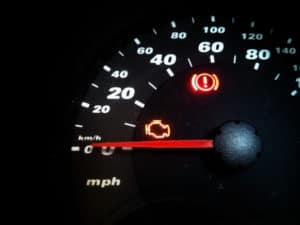
Imagine driving through a mountain pass with your family and you see the dreaded “check engine light” appear on the dashboard. Even worse, the vehicle downshifts and limits you to maybe 45 mph max. Thoughts of safety and finances both come flashing into your mind as you try to pull over to the side of the road. Few people even know about limp mode let alone ask what limp mode is. There are a few articles out there written for other mechanics on the topic. Here we aim to make take make it easy to understand what is limp mode on a car, common causes of limp mode, and how to get a car out of limp mode.
Also called Failed Code Conditions, Limp Mode occurs when the vehicle’s computer recognizes there is something wrong and the vehicle is no longer able to operate under normal conditions without causing damage. There are many problems that could trigger limp mode but essentially when the computer in your car receives a signal from your transmission or other parts, vehicle car shifts into emergency mode to protect further damage. This is why RPMs are limited and the check engine light comes on.
What Can Cause a Car to Go into Limp Mode?
Before knowing how to get a transmission out of limp mode, it’s important to understand why your car goes into limp mode in the first place. If your car goes into limp mode, there is a problem with a major element of your car. If you are experiencing symptoms such as low performance, RPMs limited to 2500-4000 or experiencing under-boosting, you most likely have an engine issue. The issue could be faulty sensors, faulty engine components or damage to the engines boost control.
Other symptoms associated with limp more is a check engine light, transmission not shifting above third gear, or generally restricted functions. Causes for these could be related to the engine but also the transmission including component damage or wiring issues. A bad brake system can also trigger limp mode.
How to Bypass Limp Mode?
Typically, if your vehicle goes into limp mode, you should be more concerned with how to safely get off the road and to a mechanic before major damage is done. We’ve been asked about how to bypass limp mode or a transmission limp mode reset enough to address the issue. What people typically mean when they ask these questions is how can I make sure their car isn’t wrong.
The first thing to do when your car goes into limp mode is to get off the road as quickly as you safely can. Once safe, turn the car off. This lets the car cool off. Most people do not have a car diagnostic scanner in their vehicle but if you do, running a scan can help determine the issue at the moment. AAA drivers typically have this on hand and can help in this process. While waiting, if you know how to check the transmission fluid, it’s a good idea to take a look.
How to Fix Limp Mode?
As mentioned, your car has a built-in mechanism to reduce power and performance to the vehicle to protect not just the car but you and the people inside of it. So, what should you do?
- Do Not Panic! Car manufacturers have created this mode to protect you and the vehicle
- If on a freeway, safely pull over to the side of the road or exit. If you must pull over to the side of the road, do the steps above.
- When on a slower road or exit, without straining the vehicle, drive to the closest service center or home. The mode is designed to allow you to drive a short distance only so don’t try to push it.
- At a service center, they will be able to diagnose the problem. If at home, follow steps above to determine if you need to call a tow truck
Conclusion
Any circumstance where your vehicle is not working properly can be scary, especially when the check engine light appears. Limp mode is a feature many people are unaware that it exists. Understanding it, however, can help allow you to make smart and safe decisions for you and your vehicle. If you are having issues with your transmission or questions feel free to contact us for more information.

Leave a Reply